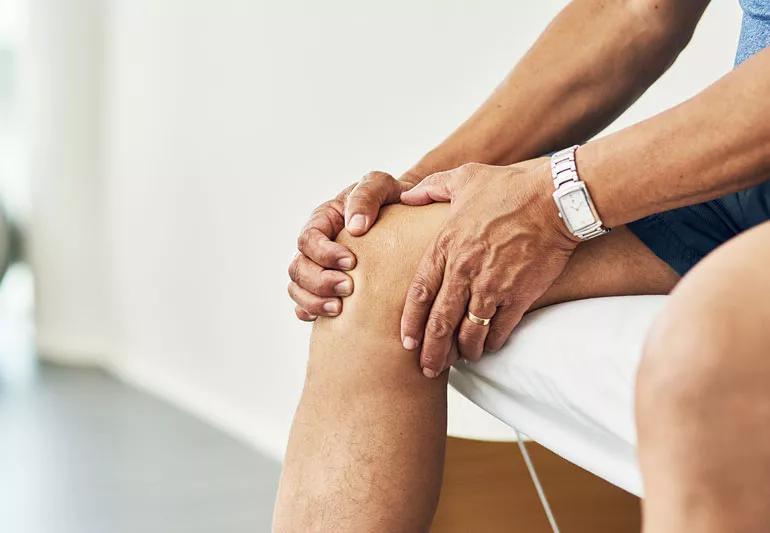Non-surgical ways to help you function better

When knee osteoarthritis worsens to a point where it can no longer be managed with nonsurgical measures, many people turn to joint replacement surgery. But there may be reasons to delay or avoid surgery. If that’s the case, you aren’t necessarily out of luck. A genicular nerve block may help ease pain enough to get you back to functioning.
Advertisement
Cleveland Clinic is a non-profit academic medical center. Advertising on our site helps support our mission. We do not endorse non-Cleveland Clinic products or services. Policy
“If knee replacement is not an option for medical reasons or you want to delay surgery so you can attend an important event, this may be an option,” says pain management specialist Robert Bolash, MD. Genicular nerve blocks may also be done for people who already had knee surgery but still have pain.
With osteoarthritis, cartilage (the smooth covering over the ends of bones in joints) breaks down and thins. This leads to inflammation and damage to other structures in and around the joint. The result is pain, swelling and stiffness.
Osteoarthritis in the knee is treated initially with measures such as physical therapy, exercise, weight loss (if overweight), a knee brace and nonsteroidal anti-inflammatory drugs. A corticosteroid injection (a powerful anti-inflammatory) can also bring relief for a short period of time. Results vary from person to person, and there is a limit to the number of these injections you can get.
If pain and dysfunction persist even with these measures and they compromise daily life, joint replacement surgery is considered. This relieves pain by replacing the natural structures in the joint with an implant made of metal and plastic.
For people who can’t have surgery or who choose to delay it, another option for pain relief is to block the nerves in the knee that transmit pain.
Advertisement
Several branches of nerves around the knee, called genicular nerves, provide sensation. Nerve blocks target at least three nerves-one on the inside and top of the knee, one on the outside and top and one on the inside and bottom.
In an office-based procedure, the physician injects an anesthetic drug, such as lidocaine or the longer-acting drugs bupivacaine or ropivacaine, on the side of the knee at each of those three spots. The injection is done using ultrasound or an X-ray machine to ensure that it is precisely targeted.
Unlike with a corticosteroid shot, which is injected into the joint, the anesthetic that is injected for a nerve block stays outside the joint. “We want to target nerves before they dive into the knee,” says Dr. Bolash.
If I wanted to cut off electricity to your house, I wouldn’t go around to every lamp. I would cut it off before it gets into the house.
“The person should notice relief within 15 to 30 minutes of the injection,” says Dr. Bolash. “We ask them to engage in activity right away to really test it out to see whether it is helpful.”
Nerve blocks typically last for a short period of time, although the effects can vary. “It can last hours, days, weeks or months and for some people even longer,” says Dr. Bolash. It’s impossible to predict.
For people who get longer-term relief for months or years, the procedure can be repeated once it wears off. If pain is eased for only a short time, such as hours or days, Dr. Bolash offers patients a longer-lasting procedure, called radiofrequency ablation, which targets the same nerves as a genicular nerve block.
Radiofrequency (RF) ablation doesn’t just anesthetize the nerves. It delivers heat that disrupts the outside of the nerves, which prevents them from sending a pain signal.
Like with a genicular nerve block, the procedure is done on an outpatient basis. It involves inserting a needle, the tip of which heats to about 176 F. Using ultrasound or X-ray guidance ensures the needle is placed directly on the nerve. An insulated needle is used to prevent other tissues from burning or getting too hot.
The heat from the needle tip creates some inflammation, which helps to disable the nerve. It also can cause some temporary soreness and swelling where the needle was inserted. Dr. Bolash recommends placing an ice pack over the area for two days.
Some people get immediate relief, but for most people it comes five to seven days later after the soreness and swelling subside.
RF ablation often provides pain relief for six months to one year. Pain can return because the disabled nerves eventually heal and regrow, and the underlying arthritis persists. At that point, the procedure can be repeated.
RF ablation doesn’t help everyone. The injection of the anesthetic drug for the nerve block is the test of whether RF ablation is likely to work. If the anesthetic relieved pain by 50% or more, even briefly, RF might be worth trying.
Advertisement
If there’s no positive response at all from the drug, your doctor will probably not move on to RF ablation.
Any time you insert a needle into the body, there are risks. For both a nerve block and RF ablation, the potential complications are bleeding, infection and damage to nearby structures. But these are rare.
Physicians reduce the risk of bleeding by using small needles. Infection is uncommon because the procedure is done in a sterile setting. Damage to other structures is minimized by using X-ray imaging or ultrasound.
“The goal is to allow people to be more active and engaged,” says Dr. Bolash. “If we get someone to less pain, that’s a good job, and if we get someone to have more function, that’s a great job.”
Dr. Bolash notes that these procedures don’t close the door on any other treatment options. If genicular nerve blocks or RF ablation don’t work, you can still have joint replacement surgery. Some people choose to have a nerve block to get pain relief while delaying surgery for a variety of reasons.
This article originally appeared in Cleveland Clinic Arthritis Advisor.
Advertisement
Learn more about our editorial process.
Advertisement

Arthritic knees can benefit from bridging, mini squats, balancing exercises and other stretches

Work on building strength and flexibility to keep the joints moving

Don't let these aches and pains set you back

Consider these common reasons for knee pain

Understanding your options

Acute pain goes away with treatment, while chronic pain is long-lasting and can be complex to manage

Find relief by keeping a neutral spine, trying a medium-firm mattress and using pillows for support

If you’re feeling short of breath, sleep can be tough — propping yourself up or sleeping on your side may help

If you fear the unknown or find yourself needing reassurance often, you may identify with this attachment style

If you’re looking to boost your gut health, it’s better to get fiber from whole foods